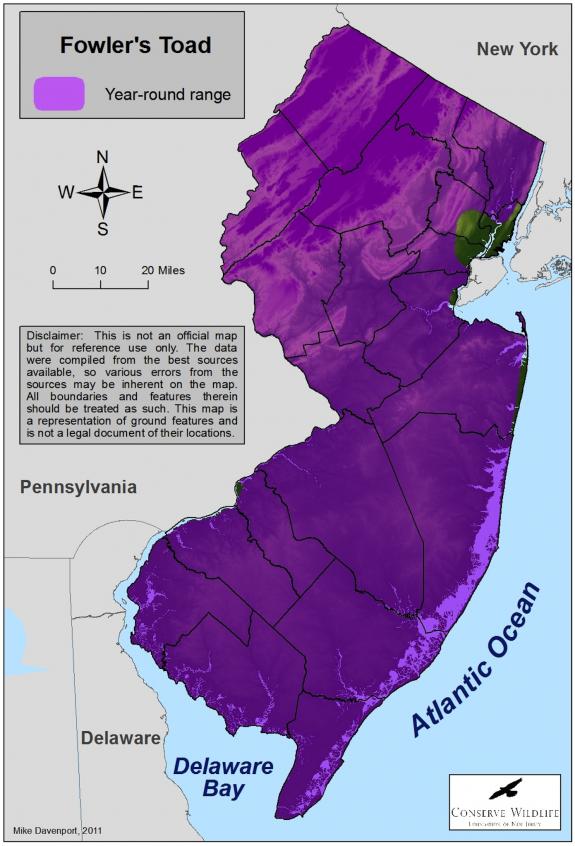Anaxyrus fowleri
Type: amphibian
Status: stable
Species Guide
Fowler's toad
Anaxyrus fowleri
Species Type: amphibian
Conservation Status: stable
IDENTIFICATION
The Fowlers toad is a mid-sized toad which can range from 2 to 3.5 inches in size. Its coloration is earth-toned ranging from gray to brown to green with darkish spots on its back. There is a light line that runs down the center of the body. Males tend to have darker coloration than females.
There are large hard ridges behind the eyes called the parotids glands, which are longer than they are wide. Three or more warts are typically found within each large dorsal spot, compared to just one or two warts per spot on the very similar American toad (Bufo americanus). American toads also have spotted bellies, whereas Fowler’s toads have just a single dark belly spot. These toads are more active at night and in March through late September.

Distribution & Habitat
The Fowler’s toad ranges from Lake Michigan east to New Jersey, south to the Gulf Coast including most states except South Carolina, Georgia and Florida. They are also found in parts of Texas, Missouri and Illinois.
The species prefers open woodlands, sandy prairies, meadows, and beaches. During the colder months and extreme hot, dry periods they burrow underground for protection.
Diet
The Fowler’s toad’s diet consists of insects and smaller invertebrates. The larvae eat small pieces of organic matter and plant tissue.
Life Cycle
Breeding sites include shallow waters of marshy areas, rain pools, lakes, and other flooded areas. Breeding season occurs from late spring to mid August usually after a heavy rainfall. Breeding calls are loud and last about 1-5 seconds and are done several times per minute. Females lay thousands of eggs in long jelly-like strings. They are black on top and tan underneath. The eggs hatch within a week and development into small toads takes about 1-2 months. Tadpoles have short oval-shaped bodies with long tails and are about half an inch long.
Potential predators of the Fowler’s toad are snakes, birds, and small mammals. One defense mechanism this species has is camouflage since their coloration blends in with the earth tones in the environment. Another defense mechanism this species has is toxic skin secretions which help protect from predators. When attacked the toxins irritate the predator’s mouth and if ingested can be very poisonous. This species is also known for playing dead if they feel threatened or harmed in any way.
Current Threats, Status, and Conservation
The greatest threat to the Fowler’s toad is habitat destruction. Disruption of breeding sites is very detrimental to their existence. Human interactions such as use of off-road vehicles may easily damage the habitat of this species. Another threat to this species is chemical pollution. The pesticides and fertilizers used for lawns and agricultural land may cause drastic declines in population in some areas.
Due to population declines and habitat loss, the Fowler’s toad was listed as a species of special concern in New Jersey. In 2016, the New Jersey Endangered and Nongame Advisory Committee recommended changing this species’ status from Special Concern to stable within the state and the status update was adopted in January 2025.
Scientific Classification
- Kingdom: Animalia
- Phylum: Chordata
- Class: Amphibia
- Order: Anura
- Family: Bufonidae
- Genus: Anaxyrus
- Species: A. fowleri